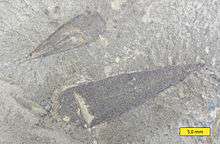Hyolitha
| Hyolitha Temporal range: Fortunian to end Permian, 536–252.2 Ma[1][2][3] | |
|---|---|
| | |
| Hyolithes cerops, Spence Shale, Idaho (Middle Cambrian) | |
| Scientific classification | |
| Kingdom: | Animalia |
| Phylum: | incertae sedis |
| Class: | †Hyolitha Marek, 1963 |
| Orders | |
Hyoliths are enigmatic invertebrate animals with small conical shells known from the Palaeozoic Era.
Morphology
The calcareous – probably aragonitic[4] – shells have a cover (operculum) and two curved supports known as helens, all of which grew by marginal accretion.[4] Most are one to four centimeters in length and are triangular ormus elliptical in cross section. Some species have rings or stripes.
Shell
The orthothecid shell has an internal layer with a microstructure of transverse bundles, and an external layer comprising longitudinal bundles.[4]
Helens
Helens are long structures that taper as they logarithmically coil gently in a ventral direction.[4]
The helens were calcareous, with an organic component, and had an organic-rich central core surrounded by concentric laminae of calcite. They grew by the addition of new material at their base, on the cavity side, leaving growth lines.[4] They were originally described by Walcott as separate fossils under the genus name Helenia, (Walcott's wife was named Helena and his daughter Helen); Bruce Runnegar adopted the name helen when they were recognized as part of the hyolith organism.[4]
Operculum
The operculum closes perfectly over the aperture of the shell, leaving two gaps through which the helens can protrude.[4] It comprises two parts: the cardinal shield, a flat region at the top of the shell; and the conical shield, the bottom part, which is more conical.[4] The inside of the shell bears a number of protrusions, notably the dorsal cardinal processes and the radially-arranged clavicles.[4]
Taxonomy
The hyoliths are divided into two orders, the Hyolithida and the Orthothecida.
Hyolitha have dorso-ventrally differentiated opercula, with the ventral surface of the shell extending forwards to form a shelf termed the ligula.[4]
The Orthothecida are somewhat more problematic, and probably contain a number of non-hyoliths simply because they are so difficult to identify with confidence, especially if their operculum is absent.[4] They have a straight (planar) opening, sometimes with a notch on the bottom side, and sealed with an operculum that has no ligula, clavicles, furrow or rooflets.[5]
Hyptiotheca is an unusual hyolithid, in that it lacks clavicles.[5]
Orthothecids fall into two groups: one, the orcothecida sensu stricto,[6] is kidney or heart shaped in cross-section due to a longitudinal groove on its ventral surface, and its opercula bear cardinal processes; the other has a rounded cross-section and often lacks cardinal processes, making them difficult to distinguish from other cornet-shaped calcareous organisms.[5] All were sessile and benthic; some may have been filter feeders.[6]
Phylogenetic position

Because hyoliths are extinct and do not obviously resemble any extant group, it is unclear which living group they are most closely related to. They may be molluscs; authors who suggest that they deserve their own phylum do not comment on the position of this phylum in the tree of life.[7] Their grade of organization is considered to be of the 'mollusc-annelid-sipunculid' level,[8] consistent with a Lophotrochozoan affinity, and comparison is usually drawn with the molluscs or sipunculids.[8][9] Older studies (predating the Lophotrochozoan concept) consider hyoliths to represent a stem lineage of the clade containing (Mollusca + Annelida + Arthropoda).[3]
Ecology
They were probably benthic (bottom-dwellers).
In the Cambrian, their global distribution shows no sign of provinciality, suggesting a long-lived planktonic larval life stage; but by the Ordovician distinct assemblages were becoming evident.[5]
Some orthothecids are preserved in vertical [life] orientation, suggesting a sessile suspension-feeding habit; hyolithids tend to be flat on the bottom, and their shape and the occurrence of epibionts are consistent with a sessile suspension feeding habit via orientation relative to passive currents.[10]
Occurrence
The first hyolith fossils appeared about 540 million years ago in the Purella antiqua Zone of the Nemakit-Daldynian Stage of Siberia and in its analogue the Paragloborilus subglobosus–Purella squamulosa Zone of the Meishucunian Stage of China. Hyolith abundance and diversity attain a maximum in the Cambrian, followed by a progressive decline up to their Permian extinction.[2][11]
References
- ↑ Kouchinsky, A.; Bengtson, S.; Runnegar, B.; Skovsted, C.; Steiner, M.; Vendrasco, M. (March 2012). "Chronology of early Cambrian biomineralization". Geological Magazine. 149 (2): 221–251. doi:10.1017/S0016756811000720.
- 1 2 Malinky, J. M. (2009). "Permian Hyolithida from Australia: The Last of the Hyoliths?". Journal of Paleontology. 83: 147–152. doi:10.1666/08-094R.1.
- 1 2 Runnegar, Bruce; Pojeta, John; Morris, Noel J.; Taylor, John D.; Taylor, Michael E.; McClung, Graham (1975). "Biology of the Hyolitha". Lethaia. 8 (2): 181. doi:10.1111/j.1502-3931.1975.tb01311.x.
- 1 2 3 4 5 6 7 8 9 10 11 Mus, M. Martí; Bergström, J. (September 2007). "Skeletal Microstructure of Helens, Lateral Spines of Hyolithids". Palaeontology. 50 (5): 1231–1243. doi:10.1111/j.1475-4983.2007.00700.x.
- 1 2 3 4 Malinky, J.M.; Skovsted, C.B. (2004). "Hyoliths and small shelly fossils from the Lower Cambrian of North−East Greenland". Acta Palaeontologica Polonica. 49 (4): 551–578.
- 1 2 Malinky, J. M. (2009). "First Occurrence of Orthotheca Novák, 1886 (Hyolitha, Early Devonian) in North America". Journal of Paleontology. 83 (4): 588–596. doi:10.1666/08-164R.1.
- ↑ Malinky, John M. (2009). "Permian Hyolithida from Australia: The Last of the Hyoliths?". Journal of Paleontology. 83: 147–152. doi:10.1666/08-094R.1. JSTOR 29739075.
- 1 2 Runnegar, B. (January 1980). "Hyolitha: Status of the phylum". Lethaia. 13: 21. doi:10.1111/j.1502-3931.1980.tb01025.x.
- ↑ Kouchinsky, A. V. (2000). "Skeletal microstructures of hyoliths from the Early Cambrian of Siberia". Alcheringa: an Australasian Journal of Palaeontology. 24 (2): 65–81. doi:10.1080/03115510008619525.
- ↑ Kouchinsky, A. V (2000). Mollusks, hyoliths, stenothecoids and coeloscleritophorans. Ecol. Cambr. Radiat., 326–349.
- ↑ Steiner, M.; Li, G.; Qian, Y.; Zhu, M.; Erdtmann, B. D. (2007). "Neoproterozoic to Early Cambrian small shelly fossil assemblages and a revised biostratigraphic correlation of the Yangtze Platform (China)". Palaeogeography, Palaeoclimatology, Palaeoecology. 254: 67. doi:10.1016/j.palaeo.2007.03.046.